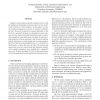Free Online Productivity Tools
i2Speak
i2Symbol
i2OCR
iTex2Img
iWeb2Print
iWeb2Shot
i2Type
iPdf2Split
iPdf2Merge
i2Bopomofo
i2Arabic
i2Style
i2Image
i2PDF
iLatex2Rtf
Sci2ools
ASAP
2008
IEEE
2008
IEEE
Bit matrix multiplication in commodity processors
Registers in processors generally contain words or, with the addition of multimedia extensions, short vectors of subwords of bytes or 16-bit elements. In this paper, we view the contents of registers as vectors or matrices of individual bits. However, the facility to operate efficiently on the bit-level is generally lacking. A commodity processor usually only has logical and shift instructions and occasionally population count instructions. Perhaps the most powerful primitive bit-level operation is the bit matrix multiply (BMM) instruction, currently found only in supercomputers like Cray. This instruction multiplies two n×n bit matrices. In this paper, we show the power of BMM. We propose and analyze new processor instructions that implement simpler BMM primitive operations more suitable for a commodity processor. We show the impact of BMM on the performance of critical application kernels and discuss its hardware cost.
ASAP 2008 | BMM Primitive Operations | Commodity Processor | Distributed And Parallel Computing | N×n Bit Matrices |
Related Content
| Added | 29 May 2010 |
| Updated | 29 May 2010 |
| Type | Conference |
| Year | 2008 |
| Where | ASAP |
| Authors | Yedidya Hilewitz, Cédric Lauradoux, Ruby B. Lee |
Comments (0)

